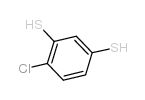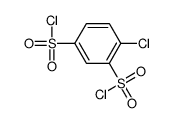58593-78-5
| Name | 4-chlorobenzene-1,3-dithiol |
|---|---|
| Synonyms |
4-chloro-benzene-1,3-dithiol
4-Chlor-1.3-dimercapto-benzol 4-Chloro-meta-benzenedithiol 4-chloro-1,3-benzenedithiol 1,3-Benzenedithiol,4-chloro 4-Chlor-1,3-benzol-dithiol EINECS 261-348-9 4-Chlor-dithioresorcin 1,3-dithio-4-chlorobenzene MFCD00004832 4-Chlor-benzen-1,3-dithiol |
| Density | 1.393 g/mL at 25 °C(lit.) |
|---|---|
| Boiling Point | 145-146 °C/13 mmHg(lit.) |
| Molecular Formula | C6H5ClS2 |
| Molecular Weight | 176.68700 |
| Flash Point | 113 °C |
| Exact Mass | 175.95200 |
| PSA | 77.60000 |
| LogP | 2.91740 |
| Index of Refraction | n20/D 1.6704(lit.) |
Synonym: Section 2 - COMPOSITION, INFORMATION ON INGREDIENTS
Risk Phrases: 36/37/38 Section 3 - HAZARDS IDENTIFICATION EMERGENCY OVERVIEW
Irritating to eyes, respiratory system and skin. Potential Health Effects Eye: Causes eye irritation. Skin: Causes skin irritation. May be harmful if absorbed through the skin. Ingestion: May cause irritation of the digestive tract. May be harmful if swallowed. Inhalation: Causes respiratory tract irritation. May be harmful if inhaled. Chronic: Not available. Section 4 - FIRST AID MEASURES Eyes: Flush eyes with plenty of water for at least 15 minutes, occasionally lifting the upper and lower eyelids. Get medical aid. Skin: Get medical aid. Flush skin with plenty of water for at least 15 minutes while removing contaminated clothing and shoes. Ingestion: Get medical aid. Wash mouth out with water. Inhalation: Remove from exposure and move to fresh air immediately. If not breathing, give artificial respiration. If breathing is difficult, give oxygen. Get medical aid. Notes to Physician: Treat symptomatically and supportively. Section 5 - FIRE FIGHTING MEASURES General Information: As in any fire, wear a self-contained breathing apparatus in pressure-demand, MSHA/NIOSH (approved or equivalent), and full protective gear. Extinguishing Media: Use water spray, dry chemical, carbon dioxide, or chemical foam. Section 6 - ACCIDENTAL RELEASE MEASURES General Information: Use proper personal protective equipment as indicated in Section 8. Spills/Leaks: Absorb spill with inert material (e.g. vermiculite, sand or earth), then place in suitable container. Section 7 - HANDLING and STORAGE Handling: Avoid breathing dust, vapor, mist, or gas. Avoid contact with skin and eyes. Storage: Store in a cool, dry place. Store in a tightly closed container. Section 8 - EXPOSURE CONTROLS, PERSONAL PROTECTION Engineering Controls: Facilities storing or utilizing this material should be equipped with an eyewash facility and a safety shower. Use adequate ventilation to keep airborne concentrations low. Exposure Limits CAS# 58593-78-5: Personal Protective Equipment Eyes: Not available. Skin: Wear appropriate protective gloves to prevent skin exposure. Clothing: Wear appropriate protective clothing to prevent skin exposure. Respirators: Follow the OSHA respirator regulations found in 29 CFR 1910.134 or European Standard EN 149. Use a NIOSH/MSHA or European Standard EN 149 approved respirator if exposure limits are exceeded or if irritation or other symptoms are experienced. Section 9 - PHYSICAL AND CHEMICAL PROPERTIES Physical State: Liquid Color: colorless to yellow Odor: stench pH: Not available. Vapor Pressure: Not available. Viscosity: Not available. Boiling Point: 145 - 146 deg C @13mmHg Freezing/Melting Point: Not available. Autoignition Temperature: Not available. Flash Point: 113 deg C ( 235.40 deg F) Explosion Limits, lower: Not available. Explosion Limits, upper: Not available. Decomposition Temperature: Solubility in water: Specific Gravity/Density: 1.393 Molecular Formula: C6H5ClS2 Molecular Weight: 176.68 Section 10 - STABILITY AND REACTIVITY Chemical Stability: Not available. Conditions to Avoid: Incompatible materials. Incompatibilities with Other Materials: Strong oxidizing agents. Hazardous Decomposition Products: Hydrogen chloride, carbon monoxide, carbon dioxide, sulfur oxides (SOx), including sulfur oxide and sulfur dioxide. Hazardous Polymerization: Has not been reported Section 11 - TOXICOLOGICAL INFORMATION RTECS#: CAS# 58593-78-5 unlisted. LD50/LC50: Not available. Carcinogenicity: 4-Chloro-1,3-benzenedithiol - Not listed by ACGIH, IARC, or NTP. Section 12 - ECOLOGICAL INFORMATION Section 13 - DISPOSAL CONSIDERATIONS Dispose of in a manner consistent with federal, state, and local regulations. Section 14 - TRANSPORT INFORMATION IATA Shipping Name: AVIATION REGULATED LIQUID, N.O.S.* Hazard Class: 9 UN Number: 3334 Packing Group: IMO Shipping Name: Not regulated. Hazard Class: UN Number: Packing Group: RID/ADR Shipping Name: Not regulated. Hazard Class: UN Number: Packing group: Section 15 - REGULATORY INFORMATION European/International Regulations European Labeling in Accordance with EC Directives Hazard Symbols: XI Risk Phrases: R 36/37/38 Irritating to eyes, respiratory system and skin. Safety Phrases: S 26 In case of contact with eyes, rinse immediately with plenty of water and seek medical advice. S 37/39 Wear suitable gloves and eye/face protection. WGK (Water Danger/Protection) CAS# 58593-78-5: No information available. Canada None of the chemicals in this product are listed on the DSL/NDSL list. CAS# 58593-78-5 is not listed on Canada's Ingredient Disclosure List. US FEDERAL TSCA CAS# 58593-78-5 is not listed on the TSCA inventory. It is for research and development use only. SECTION 16 - ADDITIONAL INFORMATION N/A |
| RIDADR | UN 2810 6.1/PG 3 |
|---|
|
~% 
58593-78-5 |
| Literature: Journal of Scientific and Industrial Research, , vol. 13 B, p. 829,833 |
|
~% 
58593-78-5 |
| Literature: Canadian Journal of Chemistry, , vol. 63, p. 2471 - 2475 |

